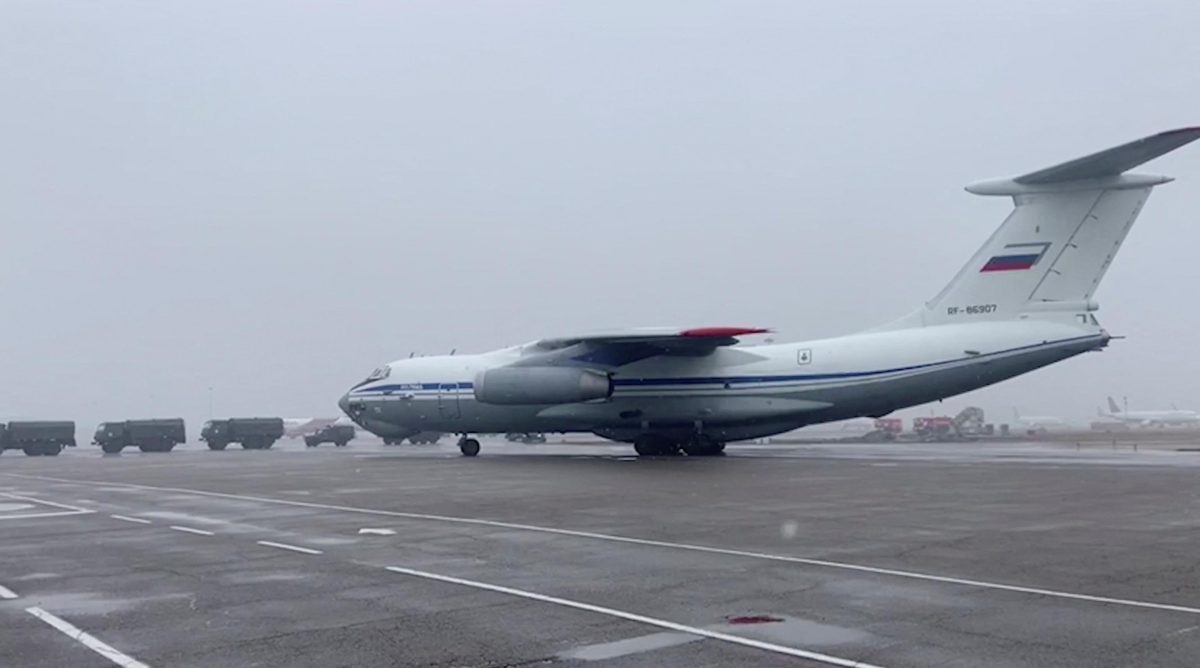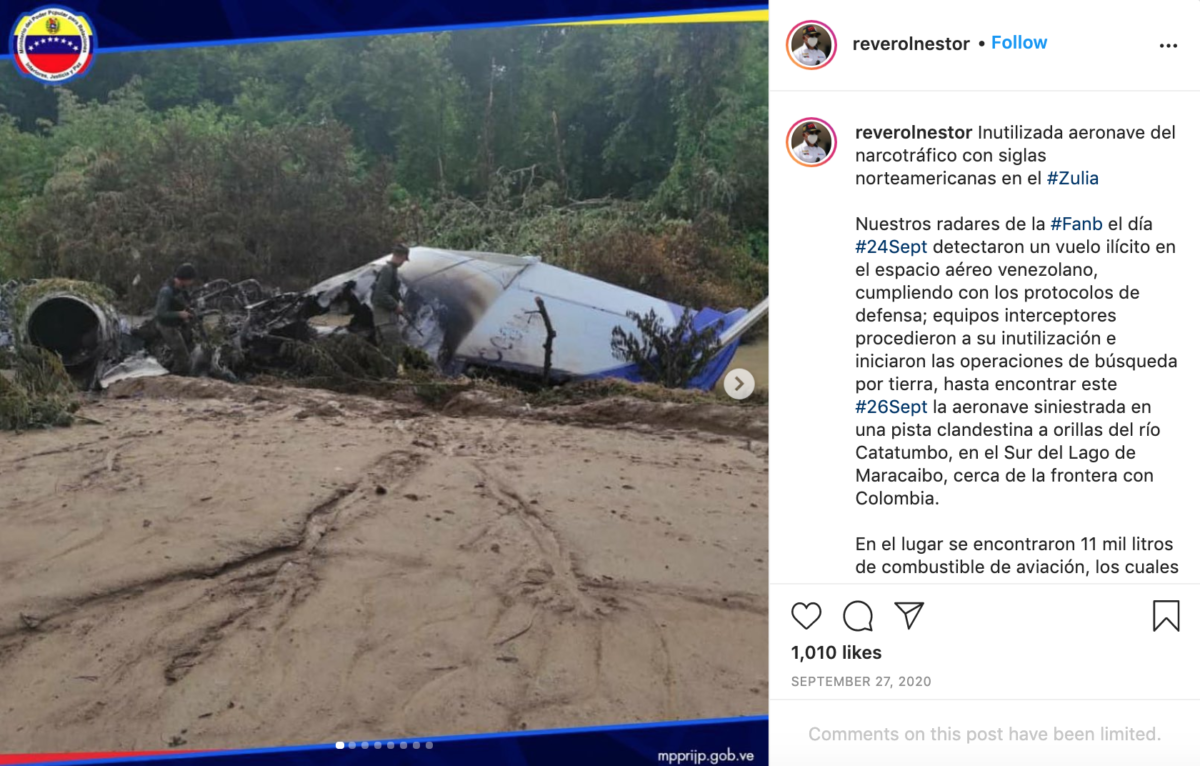Launching an Open Source Aircraft Database for Venezuela
Aircraft tracking has become a prominent feature of the open source researcher’s toolbox in recent years. Aircraft tracking websites allow anyone to keep their eyes on everything from police activity to COVID-19 vaccine deliveries. As I wrote in this guide, the ability to know what aircraft are doing in the air at any moment can help you follow along with developing events, or even get a jump on the news.
Many civil aviation authorities make aircraft registration details available online. This is the case with the Federal Aviation Administration’s (FAA) FAA Registry, Transport Canada’s Canadian Civil Aircraft Register, and the United Kingdom’s G-Info Registry pages, for example. If you know an aircraft’s registration number, you can look it up in its respective country’s registry page and find out information like the model of the aircraft, its serial number, and to whom it is registered.
However, not all civil aviation authorities make aircraft registry information available in this way. This is the case with Venezuela, where the Instituto Nacional de Aeronautica Civil (National Institute of Civil Aviation, or INAC) provides no such information online. This means that researchers interested in information about Venezuela-registered aircraft have to look to other sources for data.
In January 2020, I started an open database of aircraft registered in Venezuela. Using open source flight tracking data and helpful tips from aircraft tracking enthusiasts, the database now includes details on approximately 240 aircraft. The vast majority of these aircraft are registered in Venezuela, but some are foreign-registered with some connection to the country (more on that later).
The database is designed to be a centralized repository of aircraft identifiers like registrations and serial numbers. It also holds additional information like pictures from airplane spotters and flight history. While the ownership of some aircraft is obvious (as with commercial aircraft registered to airlines), determining who owns and operates others is much more difficult. This is why it is useful to know where aircraft have travelled to and when, as these movements could be correlated with those of Venezuela’s rich and powerful.
La Base de Datos
The vast majority of the information in the database comes from a combination of sources, namely four flight tracking platforms: adsbexchange.com, opensky-network.org, flightradar24.com, and radarbox24.com. Most of the data was collected over the past year via live-monitoring of these sites. I also received helpful contributions from aircraft enthusiasts who provided data about aircraft, as well as formatting tips on how to make the database more useful.
The databases’ columns are categorized in the following way: four “identifier” columns, one “notes” column, and (at the moment) ten “additional information” columns.
What follows is a guide that describes the purpose of each column as well as some early examples that detail how the database has been used to good effect already.
One thing to note, the columns are populated using the CONCATENATE function on Google Sheets, which allows for the joining together of strings and the automatic population of URLs. Flight tracking sites typically require you to enter either an airplane’s registration or its 24-bit ICAO address in order to perform a search.
But by looking at how each website populates its URLs once a search is undertaken you can use the CONCATENATE function to predict and automatically fill out the full required URL search for other relevant airplane registration or 24-bit ICAO addresses.
For example, note the image below showing results for the aircraft registered YV2966 on opensky-network.org. The url ends with “0D81C9”, which is the airplane’s 24-bit ICAO address.
Knowing that the URL structure for opensky-network.org searches ends with the aircraft’s 24-bit ICAO address, we can use the CONCATENATE function to populate the column with this data, automatically generating a link to the site. In the image below, “$D73” refers to column D, which contains 24-bit ICAO address, and row 73, which contains that address for YV2966.

You can see the CONCATENATE function at work in the red box above. The function adds the contents of cell D73 at the end of the URL for a search on opensky-network.org.
With that in mind, here’s how the columns break down.
The database is in Spanish because its primary audience is expected to be Venezuelan researchers and citizen journalists who are interested in keeping track of the skies above their country.
Identifiers
Columns A through D contain the aircraft’s registration, model, and manufacturer serial number, as well as its unique ICAO 24-bit address (also known as “hex code”). This information allows for the tracking of aircraft historically and in real time. In many cases, the information in the database was compiled using two or three different open sources.
The information in these columns is entered manually after an aircraft is observed in Venezuelan airspace on one of the flight tracking websites mentioned above.
Notes
Column E, “Notas”, contains any interesting or potentially relevant information regarding the aircraft. These notes can be trips that the aircraft has made in the past, or any news articles or press releases that have previously mentioned the aircraft.
For example, over a dozen aircraft on the database have appeared in sanctions lists published by the United States Department of the Treasury. Take YV2738: a Bombardier Learjet 45 that was sanctioned on 21 January 2020 along with 14 other aircraft because it belongs to Petroleos de Venezuela (PDVSA), the state-owned oil company. The sanctions were part of a broader set of actions undertaken by the Trump administration to put “pressure” on the government of Venezuelan President, Nicolas Maduro.
The notes column also contains observed landings or takeoffs from the Generalissimo Francisco de Miranda airbase in central Caracas, known colloquially as La Carlota. Private planes landing here are noteworthy because the airbase is a military installation that has been officially closed to commercial aircraft since at least 2014. General aviation and commercial aircraft typically use the Oscar Machado and Simon Bolivar International airports, located to the south and north of Caracas, respectively. Still, YV3310, a Cessna S550 Citation SI, took off from La Carlota on the morning of November 23 on a trip to Ciudad Guayana.
According to Venezuelan news outlet El Diario, Conviasa (the state-owned flag carrier) has been operating flights from La Carlota to the Los Roques island archipelago, catering to Venezuela’s rich and powerful despite the fact that the airstrip is closed to commercial traffic. Using the flight tracking tools in the database, it is possible to see which other aircraft make use of the airbase.
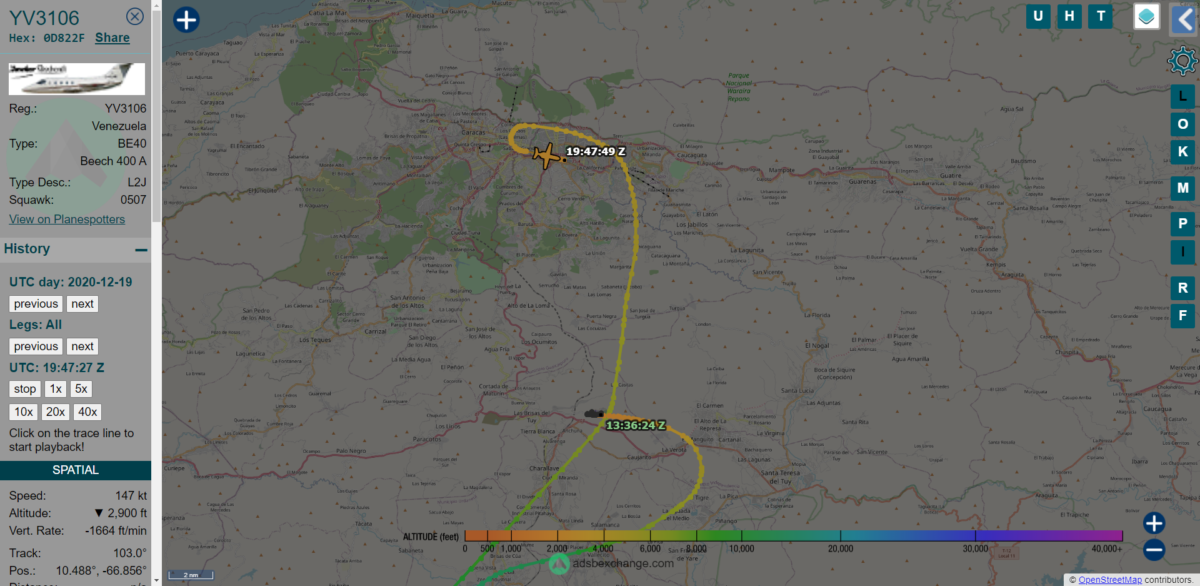
A Hawker Beechcraft 400XP jet, uses La Carlota frequently. The screenshot above shows that the aircraft took off from the Oscar Machado airport south of Caracas just after 1:30 PM GMT on December 19 2020, and that it landed at La Carlota at 7:47 PM GMT that same day (Source: Adsbexchange.com)
Additional Information
Columns F through O contain additional information for each aircraft. This information is grouped into flight history, registration data, incident data, photographs, and data pulled from Twitter.
The categories are explained below.
Flight history: Columns F-I contain flight history data from adsbexchange.com, flightradar24.com, radarbox24.com, and flightaware. Flight history can vary significantly across each site, as some sites place history behind paywalls of varying costs.
Registration Data: Column J contains registration history from planelogger.com. When such information is available, this column should show a list of any previous registrations/owners that an aircraft has had. That’s the case for YV3106: Planelogger shows that before becoming YV3016 and belonging to Conviasa, the aircraft was in service with the Brazilian Air Force as FAB2592.
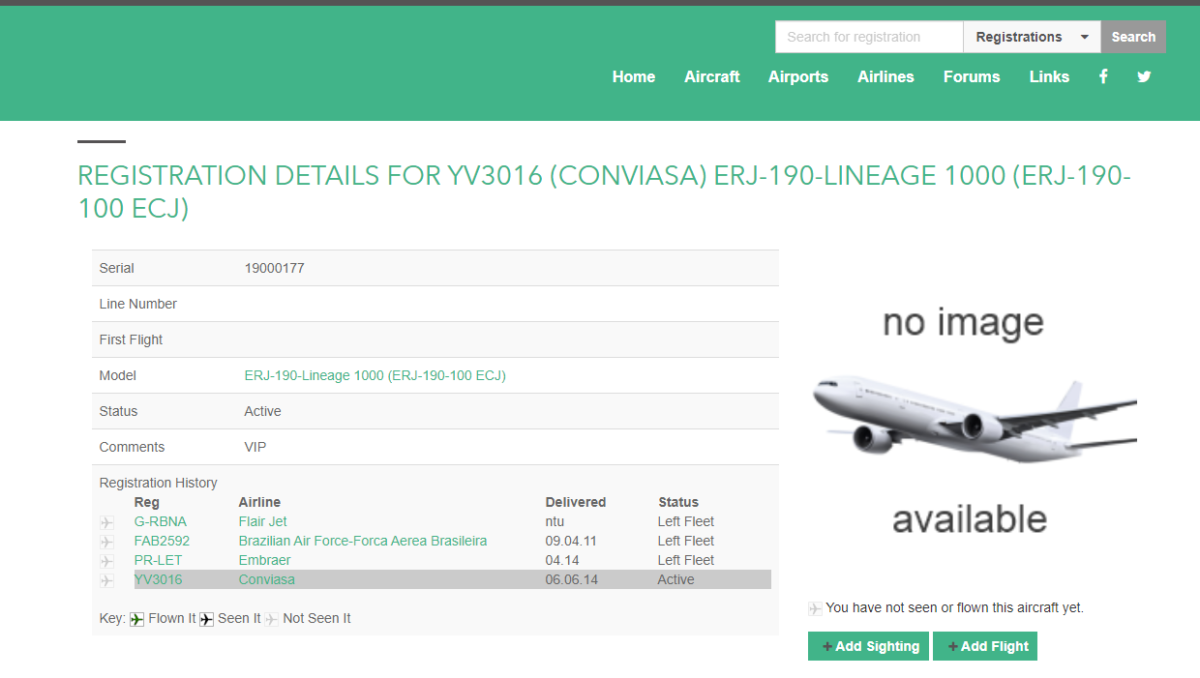
Registration history information for YV3016 taken from planelogger.com. Note that in this case the website also shows the aircraft’s manufacturer serial number (Source: planelogger.com)
Incident History: Column K shows an aircraft’s incident history from the Aviation Safety Network, a website that compiles data about aviation incidents. For example, the entry for YV1118 shows that the aircraft overran the landing strip on September 19 2017 at the Santa Elena de Uairen Airport.
Planespotter Pictures: Columns L and M contain links to images of the aircraft taken and shared by planespotters on two popular aviation image sites: planespotters.net and jetphotos.com.
These images are helpful not only in providing visual data about the aircraft, but also because they can contain information about an aircraft’s flight history. The entry for YV2152 on jetphotos.com, for example, includes an image of the aircraft that was taken at the La Aurora International Airport in Guatemala City on November 24 2017, which can act as visual confirmation of the aircraft’s presence at that location on that day.
Twitter Information: Columns N and O contain search results for tweets mentioning the aircraft’s registration or 24-bit ICAO addresses. These are the two identifiers most likely to be used by hobbyists, researchers or journalists tweeting about an aircraft.
The information in these Twitter searches can provide important context about an aircraft’s ownership and previous history in the form of tweets and threads discussing the aircraft.
Other Details: Column P includes data from opensky-network.com, a hobbyist flight tracking site. This information can include an aircraft’s serial number, its age, hex code, and registered owner.
Columns Q and R categorize the aircraft as air force, private, airline, or international, and indicate whether they are registered to Conviasa or not.
2020: A Year of Interesting Flights
The database captured several interesting flights that took place to and from Venezuela in 2020. Some of these flights are outlined below.
Starting in April 2020, Iran’s Mahan Airlines conducted a series of flights to and from Venezuela. The flights came as Iran’s Civil Aviation Organization announced that the airline would be providing a Tehran – Caracas flight.
While some Mahan Air flights flew that route, Iranian aircraft also flew to Las Piedras, an airport located in the Paraguana Peninsula in the state of Falcon. Because the airport does not normally service international flights, local media reports speculated that the flights had something to do with the Paraguana oil refinery complex, located some five kilometers from the airport. The complex is the largest such facility in Venezuela.
Between April 23 and May 7, at least four Airbus A340-642 aircraft registered to Mahan Air flew from Tehran to Las Piedras, according to data on flightradar24.com. While most flights to Las Piedras included a layover in Algiers, some were direct from Tehran. In total, fourteen Iranian flights landed at Las Piedras during this time.
The table below shows which aircraft flew from Tehran to Las Piedras on which day, and whether or not they had a layover in Algiers. Note that there does not appear to have been a flight on April 24.
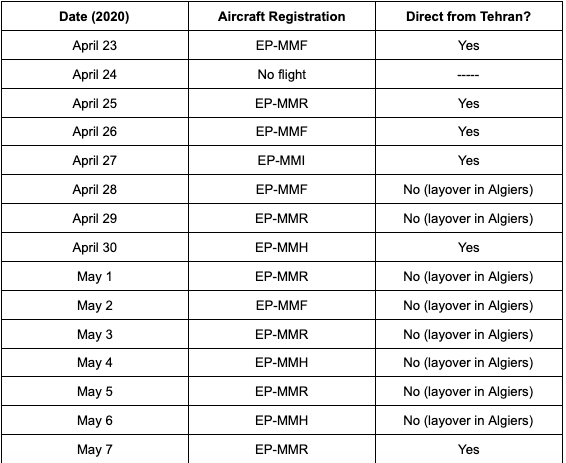
Note that based on flight history data from flightradar24.com, there was no Mahan Air flight to Las Piedras on April 24, 2020.
Alex Saab’s Flight to Cape Verde
Alex Saab is a Colombian businessman whose financial dealings have featured in a number of Venezuelan media reports in recent years.
In July 2019, Saab was indicted by the US Department of Justice on charges of money laundering. While his lawyers have since said such claims are fundamentally false, Saab was arrested in Cape Verde almost a year later. Interestingly, aircraft data seemed to track his movements in the hours before he was detained.
On June 12, 2020, a San Marino-registered (T7-JIS) Bombardier Global 5000 private jet departed eastbound from the Simon Bolivar International Airport in Maiquetia at around noon local time. I spotted the airplane departing from the airport and tweeted about it, since I had never seen an aircraft registered to the microstate operating in Venezuela before.
Strange private flight out of #Venezuela (Simon Bolivar Int'l airport) just now:
San Marino-registered (T7-JIS) Bombardier Global 5000 tracking east (hex code 50013C) pic.twitter.com/ksBQgDNNmO
— Giancarlo Fiorella (@gianfiorella) June 12, 2020
While the ADSBExchange network captured only T7-JIS’ departure from Maiquetia (and showed its registration and hex code), flightradar24.com captured the entire flight to the Cape Verde Islands off the coast of West Africa, minus the aircraft’s identifying information.
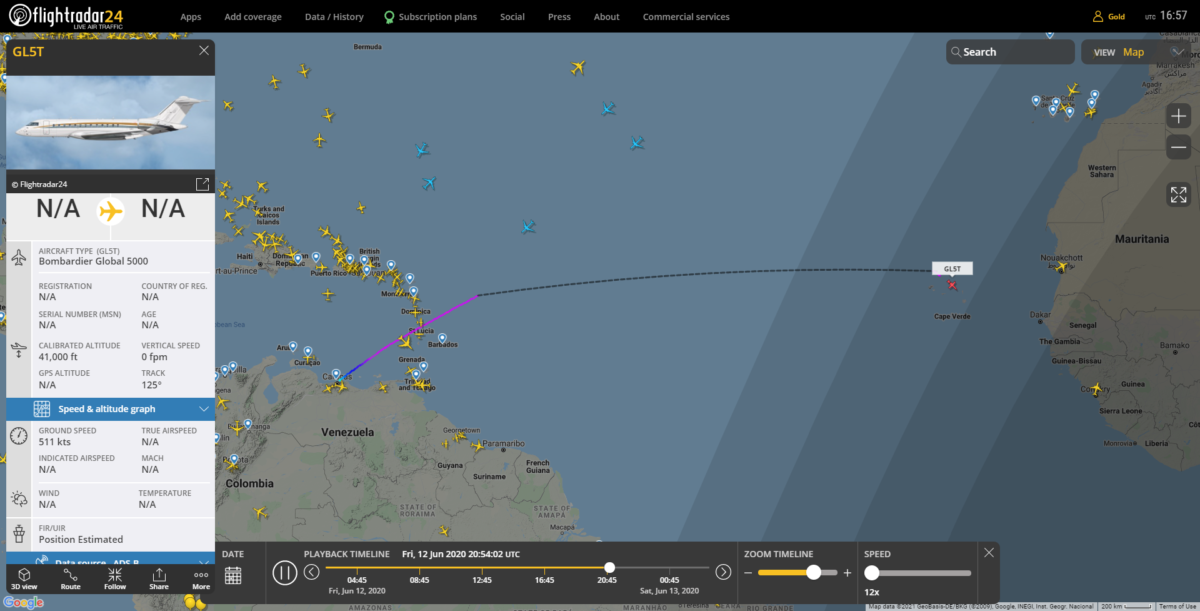
A screengrab from Flightradar24.com detailing a fight between Caracas and Cape Verde. Note that while the website captured the entire flight (minus a usual transatlantic gap in coverage), it does not display the aircraft’s registration, hex code, or other identifying information. This is not unusual, as the website often does not display identifying information for private jets.
By the end of the day, rumours had begun to swirl on Twitter that Saab had been arrested in Cape Verde. These rumours were eventually confirmed by Colombia’s El Tiempo, citing people close to Saab. In early January 2021, a court in Cape Verde approved Saab’s extradition to the United States to face money laundering charges, but the appeal process is ongoing. Saab has said in media statements that he is innocent.
Given that T7-JIS flew to Cape Verde directly from the Simon Bolivar International Airport on the same day that Saab was arrested on the island, it seems in all likelihood that this was the aircraft that flew him there.
T7-JIS returned to Venezuela from Cape Verde on June 13, 2020.
Saab claims that his arrest in Cape Verde was “arbitrary”, according to the details of a letter he wrote while in prison and published in Spanish media. The Venezuelan government considers Saab to be a diplomat with the title of “special envoy”, and has called for his immediate release.
“0000”
One aircraft on the database appears with the callsign “0000”. The ICAO address that this aircraft transmits has been set incorrectly to “0D000B”. This means that while we can see the aircraft when it is in the air across the different flight tracking platforms, we do not know what its actual registration and ICAO address are. Such mystery obviously raises interest as to who the plane may belong to and why there appears to be a level of secrecy around it.
A Venezuelan flight enthusiast named @Arr3ch0 has also been tracking “0000” over the past year. In a Twitter thread from November 2020, @Arr3ch0 indicated that “0000” is actually YV3250 based on recorded radio communications between Curacao air traffic controllers and the aircraft.
The aircraft is also interesting because it landed at the La Carlota airbase in central Caracas on several occasions, including on October 28, October 30 and November 3 2020. This would suggest that the aircraft had a special permission to do so, since the airbase is a military installation that is not normally open to civilian traffic as mentioned above.
“0000” flew to the Dominican Republic on December 4. It also flew to the Caribbean on December 30. While coverage for the aircraft dropped off before it landed, it is likely that it landed in either Turks and Caicos or The Bahamas. The aircraft returned to Venezuela later that same day. It was accompanied by another aircraft, YV3304, which appears to have flown the same route.
Other international destinations for “0000” include Mexico City and Cancun on November 12.
YV1004
YV1004 is an Airbus A340 jetliner registered to Conviasa.
While Conviasa does not offer service to European or Asian destinations, YV1004 made several trips in 2020 to and from Tehran, Iran, sometimes with layovers in Rome and Moscow.
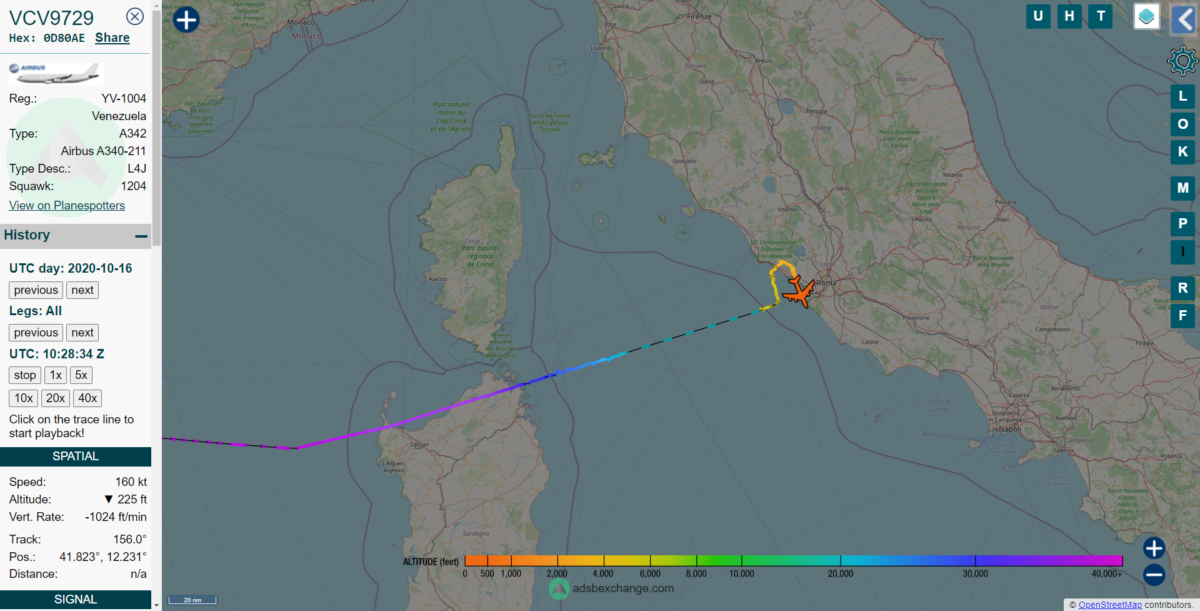
A screen grab from ADSBExchange.com shows Conviasa’s YV1004 landing at Rome’s Leonardo da Vinci International Airport on October 16, 2020. The airline does not offer flights to Rome, indicating that this might have been a refueling stop.
An investigation by Armando.info found that the aircraft was one of several Conviasa-registered airplanes that flew to and from international destinations in 2020, despite a ban on international arrivals by INAC as a precautionary measure to stem the spread of COVID-19. The ban was originally instituted for 30 days on March 13 2020, and was extended throughout 2020 with some exceptions made later in the year (for example, to allow flights from Mexico, Turkey, Bolivia, Iran, Panama, and the Dominican Republic).
Venezuela Airspace Monitor Bot
To further help track aircraft activity in Venezuela, the Bellingcat Tech Team created a Twitter account that will tweet out whenever an airplane on this database is airborne over Venezuela, or when an aircraft not yet in the database is landing or taking off in Venezuela. These automated messages contain a map of the aircraft’s journey, as well as registration numbers, make and model, altitude and speed.
YV3310, un avión desconocido, esta ascendiendo. A una altura de 2650 pies, velocidad 407 k/h, está a 2 kilometros de La Guaira. Notas: Salio de La Carlota ~7:30 AM EST Noviembre 23 2020; regreso de Barbados Diciembre 16 2020; regreso de Panama…https://t.co/fEkuX6aOfA pic.twitter.com/PWf25MMjxm
— Monitor Aéreo Venezuela (@MonitorAereo) March 3, 2021
The account, @MonitorAereo, tweets in Spanish so that it can serve as a resource for researchers, journalists, hobbyists, and ordinary people in Venezuela and beyond who are interested in knowing more about the aircraft flying above them.
“Keep watching the skies”
Even if you do not find the contents of the database relevant to your interests, I hope that its format might serve as a guide for you to build your own aircraft database. Whether you’re interested in tracking commercial flights over your home or in keeping tabs on a country’s air force, you, too, can keep eyes on the sky thanks to the wealth of open source resources available that make aircraft tracking possible.
If you want to set up a database like the one in this article and have any questions, or if you have your own database already, I’d love to hear from you. Feel free to contact me at giancarlo@bellingcat, or on Twitter @gianfiorella.

